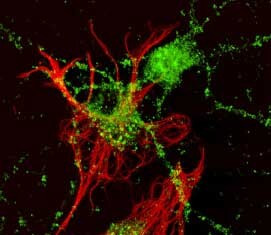Search Thermo Fisher Scientific
FIGURE: 1 / 1
Ephrin A2 Antibody (PA5-47806) in ICC/IF

Product Details
PA5-47806
Species Reactivity
Host/Isotype
Class
Type
Immunogen
Conjugate
Form
Concentration
Purification
Storage buffer
Contains
Storage conditions
Shipping conditions
RRID
Product Specific Information
In direct ELISAs and Western blots, less than 1% cross-reactivity with recombinant mouse (rm) Ephrin-A1, recombinant human (rh) Ephrin-A3, rmEphrin-A4, rhEphrin-A5, rmEphrin-B1, rmEphrin-B2, and rhEphrin-B3 is observed.
Reconstitute at 0.2 mg/mL in sterile PBS.
Endoxin level is <0.10 EU per 1 µg of the antibody by the LAL method.
Target Information
The Eph subfamily represents the largest group of receptor protein tyrosine kinases identified to date. While the biological activities of these receptors have yet to be determined, there is increasing evidence that they are involved in central nervous system function and in development. The Eph subfamily receptors of human origin (and their murine/avian homologs) include EphA1(Eph), EphA2 (Eck), EphA3 (Hek4), EphA4 (Hek8), EphA5 (Hek7), EphA6 (Hek12), EphA7 (Hek11/MDK1), EphA8 (Hek3), EphB1 (Hek6), EphB2 (Hek5), EphB3(Cek10, Hek2), EphB4 (Htk), EphB5 (Hek9) and EphB6 (Mep). Ligands for Eph receptors include ephrin-A4 (LERK-4) which binds EphA3 and EphB1. In addition, Ephrin-A2 (Elf-1) has been described as the ligand for EphA4, ephrin-A3 (Ehk1-L) as the ligand for EphA5 and ephrin-B2 (Htk-L) as the ligand for EphB4 (Htk).
For Research Use Only. Not for use in diagnostic procedures. Not for resale without express authorization.
References (0)
Bioinformatics
Protein Aliases: CEK7-L; CEK7-ligand; ELF-1; EPH related receptor tyrosine kinase ligand 6; EPH-related receptor tyrosine kinase ligand 6; ephrin A6; Ephrin-A2; EphrinA2; LERK-6
Gene Aliases: CEK7L; Efna2; Elf1; Epl6; Eplg6; Lerk6
UniProt ID: (Mouse) P52801
Entrez Gene ID: (Mouse) 13637

Performance Guarantee
If an Invitrogen™ antibody doesn't perform as described on our website or datasheet,we'll replace the product at no cost to you, or provide you with a credit for a future purchase.*
Learn more
We're here to help
Get expert recommendations for common problems or connect directly with an on staff expert for technical assistance related to applications, equipment and general product use.
Contact tech support
